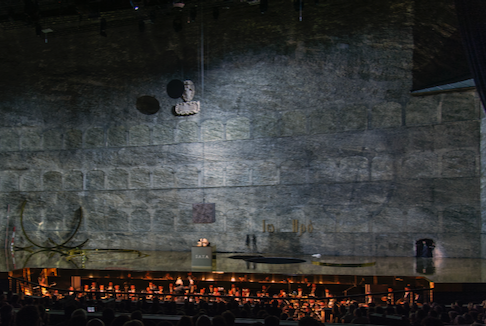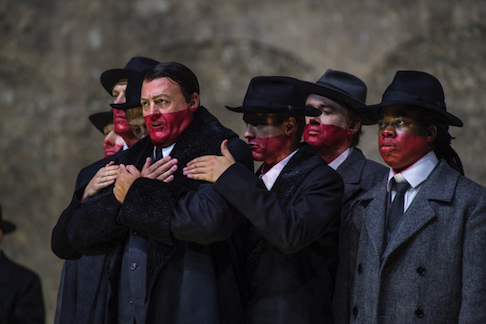![Asmik Grigorian as Salome [Photo copyright Ruth Walz, courtesy of the Salzburg Festival]](http://www.operatoday.com/Salome_Salzburg1.png)
15 Aug 2018
Salome in Salzburg
A Romeo Castellucci production is always news, it is even bigger news just now in Salzburg where Lithuanian soprano Asmik Grigorian has made her debut as the fifteen year-old Salome.
English Touring Opera are delighted to announce a season of lyric monodramas to tour nationally from October to December. The season features music for solo singer and piano by Argento, Britten, Tippett and Shostakovich with a bold and inventive approach to making opera during social distancing.
This tenth of ten Live from London concerts was in fact a recorded live performance from California. It was no less enjoyable for that, and it was also uplifting to learn that this wasn’t in fact the ‘last’ LfL event that we will be able to enjoy, courtesy of VOCES8 and their fellow vocal ensembles (more below …).
Ever since Wigmore Hall announced their superb series of autumn concerts, all streamed live and available free of charge, I’d been looking forward to this song recital by Ian Bostridge and Imogen Cooper.
The Sixteen continues its exploration of Henry Purcell’s Welcome Songs for Charles II. As with Robert King’s pioneering Purcell series begun over thirty years ago for Hyperion, Harry Christophers is recording two Welcome Songs per disc.
Although Stile Antico’s programme article for their Live from London recital introduced their selection from the many treasures of the English Renaissance in the context of the theological debates and upheavals of the Tudor and Elizabethan years, their performance was more evocative of private chamber music than of public liturgy.
In February this year, Albanian soprano Ermonela Jaho made a highly lauded debut recital at Wigmore Hall - a concert which both celebrated Opera Rara’s 50th anniversary and honoured the career of the Italian soprano Rosina Storchio (1872-1945), the star of verismo who created the title roles in Leoncavallo’s La bohème and Zazà, Mascagni’s Lodoletta and Puccini’s Madama Butterfly.
Evidently, face masks don’t stifle appreciative “Bravo!”s. And, reducing audience numbers doesn’t lower the volume of such acclamations. For, the audience at Wigmore Hall gave soprano Elizabeth Llewellyn and pianist Simon Lepper a greatly deserved warm reception and hearty response following this lunchtime recital of late-Romantic song.
Collapsology. Or, perhaps we should use the French word ‘Collapsologie’ because this is a transdisciplinary idea pretty much advocated by a series of French theorists - and apparently, mostly French theorists. It in essence focuses on the imminent collapse of modern society and all its layers - a series of escalating crises on a global scale: environmental, economic, geopolitical, governmental; the list is extensive.
For this week’s Live from London vocal recital we moved from the home of VOCES8, St Anne and St Agnes in the City of London, to Kings Place, where The Sixteen - who have been associate artists at the venue for some time - presented a programme of music and words bound together by the theme of ‘reflection’.
'Such is your divine Disposation that both you excellently understand, and royally entertaine the Exercise of Musicke.’
Amongst an avalanche of new Mahler recordings appearing at the moment (Das Lied von der Erde seems to be the most favoured, with three) this 1991 Mahler Second from the 2nd Kassel MahlerFest is one of the more interesting releases.
‘And there was war in heaven: Michael and his angels fought against the dragon; and the dragon fought and his angels, And prevailed not; neither was their place found any more in heaven … that old serpent … Satan, which deceiveth the whole world: he was cast out into the earth, and his angels were cast out with him.’
If there is one myth, it seems believed by some people today, that probably needs shattering it is that post-war recordings or performances of Wagner operas were always of exceptional quality. This 1949 Hamburg Tristan und Isolde is one of those recordings - though quite who is to blame for its many problems takes quite some unearthing.
There was never any doubt that the fifth of the twelve Met Stars Live in Concert broadcasts was going to be a palpably intense and vivid event, as well as a musically stunning and theatrically enervating experience.
‘Love’ was the theme for this Live from London performance by Apollo5. Given the complexity and diversity of that human emotion, and Apollo5’s reputation for versatility and diverse repertoire, ranging from Renaissance choral music to jazz, from contemporary classical works to popular song, it was no surprise that their programme spanned 500 years and several musical styles.
The Academy of St Martin in the Fields have titled their autumn series of eight concerts - which are taking place at 5pm and 7.30pm on two Saturdays each month at their home venue in Trafalgar Square, and being filmed for streaming the following Thursday - ‘re:connect’.
The London Symphony Orchestra opened their Autumn 2020 season with a homage to Oliver Knussen, who died at the age of 66 in July 2018. The programme traced a national musical lineage through the twentieth century, from Britten to Knussen, on to Mark-Anthony Turnage, and entwining the LSO and Rattle too.
With the Live from London digital vocal festival entering the second half of the series, the festival’s host, VOCES8, returned to their home at St Annes and St Agnes in the City of London to present a sequence of ‘Choral Dances’ - vocal music inspired by dance, embracing diverse genres from the Renaissance madrigal to swing jazz.
Just a few unison string wriggles from the opening of Mozart’s overture to Le nozze di Figaro are enough to make any opera-lover perch on the edge of their seat, in excited anticipation of the drama in music to come, so there could be no other curtain-raiser for this Gala Concert at the Royal Opera House, the latest instalment from ‘their House’ to ‘our houses’.
"Before the ending of the day, creator of all things, we pray that, with your accustomed mercy, you may watch over us."
![Asmik Grigorian as Salome [Photo copyright Ruth Walz, courtesy of the Salzburg Festival]](http://www.operatoday.com/Salome_Salzburg1.png)
A Romeo Castellucci production is always news, it is even bigger news just now in Salzburg where Lithuanian soprano Asmik Grigorian has made her debut as the fifteen year-old Salome.
Castellucci creates theater as Richard Strauss creates music. It is a language all its own, though sometimes of concrete reference it is usually an abstract flow of stimuli that create their own reality.
Here Castellucci has made a Salzburg Salome. Starting with the Latin "te saxo loquuator" (what the stones may say to you), a phrase found only in Salzburg where it is inscribed above the entry of the 18th century tunnel connecting old Salzburg with a later Salzburg built beyond its famous mountain.
Castellucci inscribes the phrase on a cloth that covers the massive galleries cut into the cliff behind the old riding school theater where he holds us in silence, save a cricket sounding. Finally the cloth parts to reveal that the galleries have been filled in with stone creating a gigantic cavern. Specific images appear, Salome in a white dress stained by menstrual blood standing on the huge mirrored floor, a displaced disk revealing a black hole.
 The dance
The dance
Only when we have fully entered into Castellucci’s theater does the Strauss music begin. The players of the Vienna Philharmonic and maestro Franz Welzer-Möst become very present in the Castellucci's theater world — they themselves in fact become the dance that dooms the 15 year-old princess — Salome herself folded, immobile on a pedestal during the dance, a huge square cut stone slowly descending to crush her under its massive weight (sublime choreography by Castellucci collaborator Cindy Van Acker).
Castellucci’s implacable stone world reflects everything except the black voids he creates for the prophet’s aura and for Herod’s doom. There is no color save the occasional lightening flashes of brilliant red or blue and the painted red faces of Herodes, Narraboth, and the black-hatted Jews and the Nazarenes, and the huge gold, rolling wine chalice that links the brass horns of the pit to the stage.
A live black stallion dances a vista in Jochanaan’s cistern to Salome’s orchestrally created sexual fantasy. It is the stallion’s severed head that is then presented to Salome. In the final moments of the opera Salome herself descends into a pit — the final image of Castellucci’s theater is Salome’s head, a deathly silver light illuminating her face.
Like all productions in the Felsenreitschule (the name of the old riding school theater) Castellucci’s Salome is site specific. Thus I have spoiled nothing for you by revealing a few of its more striking images — the production is and will always be unique to these stones of Salzburg and its festival and for all that this may mean.
The sine non qua of the Castellucci production is its protagonist, Lithuanian soprano Asmik Grigorian. Diminutive, lithe, of fresh and beautiful voice to her death and dramatically expansive in her movements this extraordinary artist was as real and vivid a presence in Strauss’ account of an adolescent awakening as was the black stallion that was Jochanaan.
 John Daszak as Herod
John Daszak as Herod
The prurient world surrounding Salome’s innocence erupted into a frenzy of battling images, during which the salient image was the cleansing of Jochanaan’s blackened body. Conductor Welzer-Möst’s orchestra created a frantic orgy of argument clearly visible in the a vista pit. The physical presence of the Vienna Philharmonic within the confines of the Castellucci theater world engendered a toxicity of enormous and hugely indulgent proportion.
English tenor John Daszak was the stark Herodes, his tormented spirit dominating every moment of Castellucci’s theater. Hungarian bass-baritone Gábor Bretz menacingly rang out his prophecies and admonitions shrouded in blackness. The pleas and imprecations of Italian mezzo soprano Anna Maria Chiuri’s Herodias were largely overlooked in the fracas of Castellucci’s powerfully masculine world, Salome its innocent victim.
Michael Milenski
Cast and production information:
Herod: John Daszak: Herodias: Anna Maria Chiuri; Salome: Asmik Grigorian; Jochanaan: Gábor Bretz; Narraboth: Julian Prégardien; Herodias' page: Avery Amereau; Jews/Nazarines/Soldiers: Matthäus Schmidlechner, Mathias Frey, Patrick Vogel, Jörg Schneider, David Steffens, Tilmann Rönnebeck, Paweł Trojak, Neven Crnić, Henning von Schulman, Dashon Burton. The Vienna Philharmonic. Conductor: Franz Welser-Möst; Production (stage direction, sets, costumes and lighting): Romeo Castellucci.